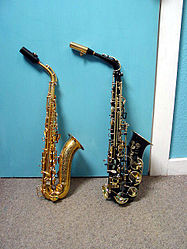- Mezzo-soprano saxophone
-
Mezzo-soprano saxophone 
Mezzo-soprano (left) and alto (right) saxophones.Classification Aerophone Hornbostel–Sachs classification 422.212-71
(Single-reeded aerophone with keys)Inventor(s) Adolphe Sax Developed 28th June 1846[1] Playing range
In F: sounds a perfect fifth lower than written.
Sounding:
Related instruments Military band family:
- Sopranino saxophone
- Soprano saxophone
- Alto saxophone
- Tenor saxophone
- Baritone saxophone
- Bass saxophone
- Contrabass saxophone
- Subcontrabass saxophone
Orchestral family:
- C soprano saxophone
- Mezzo-soprano saxophone
- C melody saxophone
Other saxophones:
- Sopranissimo saxophone ('Soprillo')
- Tubax
Musicians More articles The mezzo-soprano saxophone, sometimes called the F alto saxophone, is an instrument in the saxophone family. It is in the key of F, pitched a whole step above the alto saxophone. Its size and the sound are similar to the E♭ alto, although the upper register sounds more like a B♭ soprano. Very few mezzo-sopranos exist — they were only produced in 1928 and 1929 by the C. G. Conn company. They were not popular and did not sell widely, as their production coincided with the Wall Street Crash of 1929 and the Great Depression. Harsh economic conditions forced Conn to reduce the range of saxophones they produced to the most popular models.
Conn used the surplus stock of mezzo-sopranos to teach instrument repair in Conn's Elkhart workshops. Typically, a Conn instructor would deliberately damage the mezzo-sopranos (e.g. dropping them onto a concrete floor) and the students would then be tasked with repairing them. The repeated wear and tear of these actions eventually destroyed the saxophones.
The mezzo-soprano is the only saxophone pitched in F, apart from a few prototypes of an F baritone saxophone. Although Maurice Ravel's 1928 orchestral work Boléro calls for a sopranino saxophone in F, it is unlikely that such an instrument ever existed.
Notable players of the mezzo-soprano saxophone include Anthony Braxton, James Carter, and Jay Easton.
In classical music
It was asked for by Richard Strauss in his Sinfonia Domestica written in 1903-1904, where included in the music are parts for four saxophones including an alto saxophone in F.
References
- ^ "June 28, 1846: Parisian Inventor Patents Saxophone". Wired.com. http://www.wired.com/thisdayintech/2010/06/0628saxophone-patent. Retrieved 14 February 2011.
External links
- Jay C. Easton - modern & unusual woodwinds Jay Easton's alto and mezzo-soprano page, with photographs and sound clips.
Types of Saxophones †Soprillo saxophone • Sopranino saxophone • C Soprano saxophone • Soprano saxophone • Mezzo-soprano saxophone • Alto saxophone • C melody saxophone • Tenor saxophone • Baritone saxophone • Bass saxophone • Contrabass saxophone • ‡Subcontrabass saxophone† not designed by Adolphe Sax• ‡ proposed by Adolphe Sax 
This article relating to woodwind instruments is a stub. You can help Wikipedia by expanding it.

